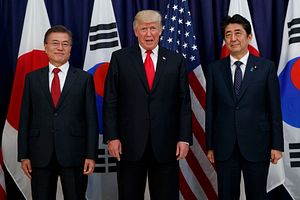The continued uncertainties with respect to ongoing U.S. alliance cost-sharing negotiations with South Korea and Japan understandably continue to attract significant headlines for their own sake. But apart from these occasional headlines, these issues also spotlight the broader question: how should observers go about assessing U.S. alliance management in Asia under the administration of U.S. President Donald Trump relative to previous periods?
Like other aspects of U.S. Asia policy, U.S. alliance management in Asia, when viewed comprehensively with respect to all five of Washington’s treaty allies in Asia – Australia, Japan, the Philippines, South Korea, and Thailand – has been through its share of challenges as well as troubling periods, with the more dramatic examples being Jimmy Carter’s initial decision to withdraw U.S. troops from South Korea in the late 1970s or the U.S. base closures in the Philippines in the early 1990s. It has also been fairly commonplace to see alliances go through periods of change with changes in the balance of power, priority shifts in administrations in the United States and in Asian allied capitals, the evolving mix of security challenges, and ongoing negotiations about the shape of burden sharing and the alignment of threat perceptions.
Under the Trump administration, U.S. alliance management has entered a rocky phase due to a confluence of developments. The focus of the headlines is often on the president’s decades-old skepticism of alliances or broader protectionist and unilateral impulses tied to an America First approach, which are not inconsequential since they have not only complicated negotiations with allies like Japan and South Korea, but also and raised questions about Washington’s reliability in other Asian capitals. In a more institutional sense, the Trump administration’s increasing focus on U.S.-China competition and its unveiling of the Free and Open Indo-Pacific approach has opened up avenues for allied cooperation but also raised new questions about how that might be shaped that still remain ahead of upcoming U.S. elections in 2020. And intraregional trends that were at play before the Trump administration came into office have not only continued but intensified, be it China’s effort to build up its own regional partnership network including with U.S. allies like Thailand and the Philippines, or the seriousness of flashpoints in the Korean Peninsula or the South China Sea.
Despite this rocky phase in U.S. alliance management, it is worth acknowledging that the Trump administration has nonetheless seen some positive developments and occasional gains on the alliance front. The administration’s focus on the China challenge has reinforced clarity on this front amid Beijing’s growing assertiveness which some allies and partners had been hoping for more of under the Obama administration. There have been efforts to shore up the two alliances in Southeast Asia, Thailand and the Philippines, which have traditionally been weaker relative to those in Japan, South Korea and Australia, with steps taken such as a joint vision statement and reinforcing commitment clarity. There has been greater attention to shoring up the resource base for U.S. defense policy, after years of defense budget reductions and cuts which affect the U.S. role as a security partner in the Asia-Pacific. And the trend of networking alliances with wider partnerships and friendships in the Indo-Pacific has not only continued but intensified, as evidenced by the momentum we have seen with trilateral mechanisms and the Quad.
The issue, however, is that the gains made in individual alliances and on broader aspects like threat clarity or resourcing may be outweighed by the uncertainties Trump has raised about alliances themselves and the future shape of U.S. regional engagement. While the gains in defense resourcing may increase U.S. capabilities, their impact may be limited by questions about future U.S. intentions as well as issues about other aspects of U.S. policy such as the diplomatic and economic realms which have seen some challenges under the Trump years. Similarly, whatever greater clarity in U.S. China policy may be offset by uncertainty about U.S. engagement, which matters because it can reduce the willingness of allies to collaborate with Washington on some fronts, exacerbate hedging tendencies, and feed into segments of elite and public opinion in Asian states that are more supportive of accommodating a more Sinocentric order. And though Trump’s transactional treatment of alliances may not be shared by the broader Washington establishment, it nonetheless risks playing into existing concerns in some pockets of allied capitals about the outdated nature of these arrangements which can in turn create challenges for policymakers.
To be sure, these challenges are not insurmountable even as they remain significant today. Indeed, there are visible efforts by U.S. policymakers to try to reinforce some of the inroads made and manage concerns that have been evident of late, be it through periodic rhetorical statements to reassure allies and partners or initiatives that focus on aspects of policy such as the building out of the non-defense aspects of FOIP. U.S. Defense Secretary Mark Esper’s recent trip out to the region saw some of this in the works as well, in spite of the manifold policy issues that were raised during each of his stops. How exactly all this will play out in a U.S. policy context amid wider trends and regional developments will prove fundamental in how the Trump administration’s overall record on alliance management plays out.

































